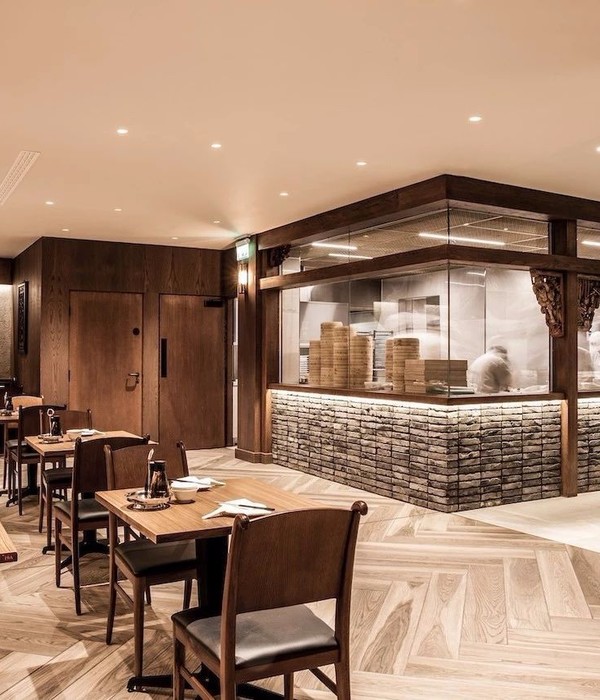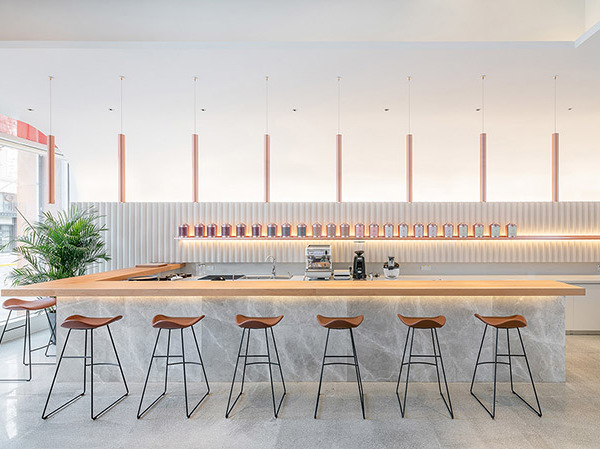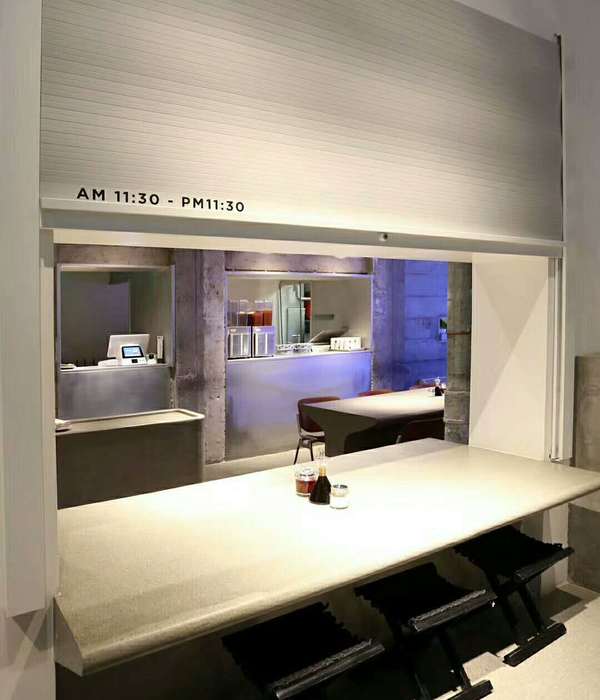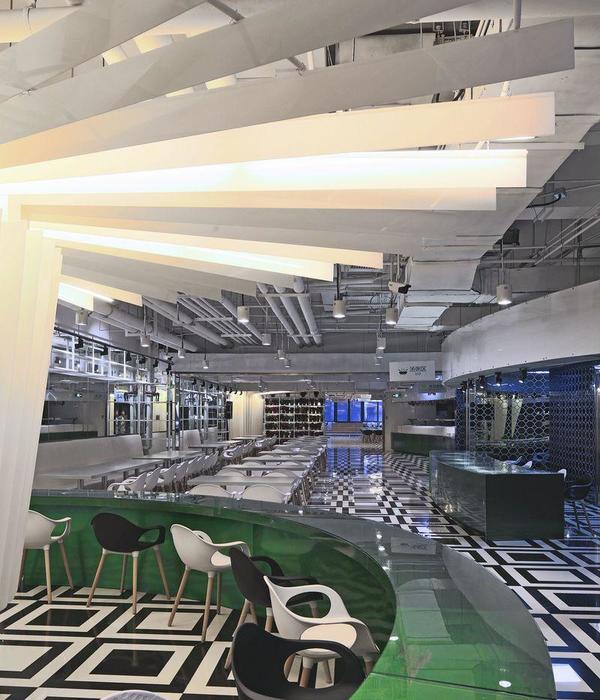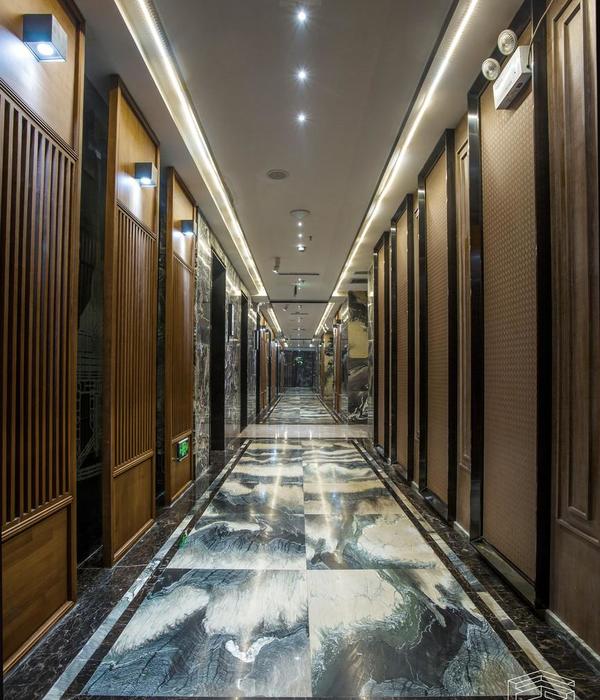气候积极设计 | 景观项目的碳影响改善策略
来自
ASLA
Climate Positive Design |
Pamela Conrad
;
CMG Landscape Architecture
项目概述
PROJECT STATEMENT
由于异常的二氧化碳水平对大气层带来的毁灭性影响,国际社会已经宣布地球进入气候紧急状态。景观项目虽然会造成碳排放,但它们同样可以通过树木和植物的固碳能力来提供有效的解决方案。不过,在没有测量方法的情况下,具体的影响程度依旧只能停留于未知。除了测量方面的挑战,还存在另一个问题:景观项目是否可以通过“使固碳量大于碳排放量”来实现对气候的积极影响。
2019年发布的“气候积极设计”(Climate Positive Design)计划旨在通过集体行动来改善建筑景观的影响。在不到一年的时间里,该计划已经从个体研究发展为多学科的国际合作,并覆盖了全世界近一半的国家。以研究为基础的“探路者”(Pathfinder)应用程序和“气候积极设计挑战”为设计师提供了指导,告诉他们如何在项目中减少碳足迹并增加碳固存。
虽然该计划是由景观设计师创建,但其线上资源亦开放并适用于其他各学科、市政部门以及普通的园艺师。到目前为止的案例研究和项目词条共同证明,我们每个人都能够成为问题解决者中的一员。
The global community has declared a climate emergency due to unprecedented levels of carbon dioxide filling the atmosphere with devastating, visible effects. While landscape projects produce emissions, they can also contribute to the solutions through tree and plant carbon sequestration. However, without a way to measure, their impacts remain unknown. Beyond the challenge of measuring, the question looms whether projects can be climate positive by sequestering more carbon than they emit.
In 2019, Climate Positive Design launched with the mission to improve the impact of built landscapes through collective action. The initiative grew from the inquiry of one to a multi-disciplinary international collaboration reaching nearly half the countries in the world in less than a year. The research-based Pathfinder application and Climate Positive Design Challenge guide designers to reduce carbon footprints while increasing carbon sequestration within their projects.
While created by landscape architects, the online resources are applicable and accessible to other disciplines, municipalities, and the everyday gardener. Case studies and project entries to date show that we can indeed be part of the solution.
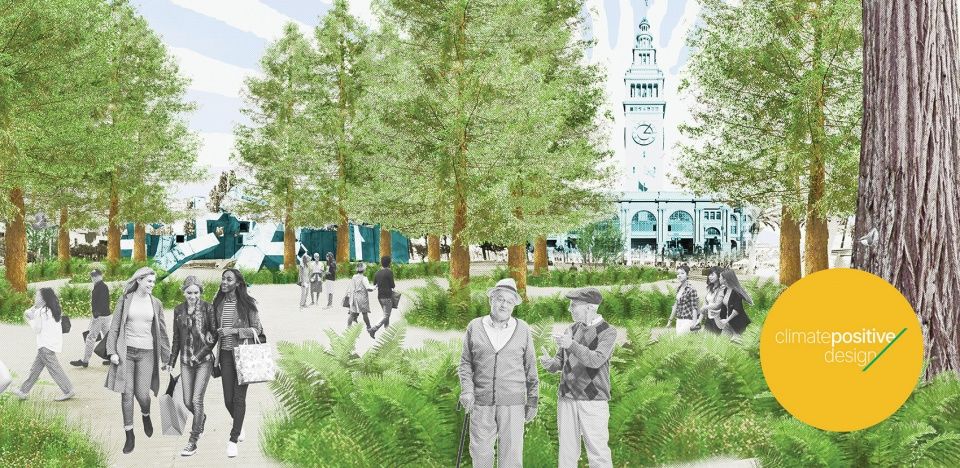
▲气候积极设计是一项启动于2019年的研究计划,旨在通过集体行动来改善建筑景观的碳影响。其使命是帮助实际项目成为固碳量大于碳排放量的“气候积极”型解决方案。Climate Positive Design: Climate Positive Design is a research initiative that launched in 2019 to improve the carbon impact of the built environment through collective action. Its mission is to help projects become Climate Positive solutions that sequester more carbon than they emit.
项目说明
PROJECT NARRATIVE
时间紧迫
2019年,气候变化专门委员会(IPCC)发出警告:为将气温上升幅度控制在1.5摄氏度内,必须在10年之内显著降低温室气体(GHG)的浓度,否则将会对地球和人类社会带来不可逆转的破坏。
建筑2030组织报告称:城市建筑环境每年排放的温室气体占据全球总量的75%,其中36%来自于建筑物外部。景观设计项目一方面造成了碳排放,另一方面也包含了能够将二氧化碳(主要的温室气体)从大气中清除的树木和植物。
景观的碳系统十分复杂,它们包括从材料制造和运输中产生的隐含碳排放,以及随着时间推移从维护和施肥过程中产生的运作碳排放。同时,景观也从大气中固存二氧化碳并将其储存于树木、植物和土壤中。在过去的十年间,人们已经开发出计算建筑性碳排放的方法,例如Athena、Tally和One-Click LCA等,而由于场地设计的有机复杂性,景观设计学科仍旧未能有效地测量、追踪或改善集体作用下的碳影响。
那么,景观设计是否能够让固碳量超过其排放量,从而实现对气候的积极影响呢?
方法
景观设计师领导了该计划的研究部分,并与环境顾问团队建立合作,就行业标准提出咨询。主要的研究方法包括以下三点:
1.文献回顾:对于与气候科学、碳固存和储存、材料的隐含碳排放以及运作碳排放相关的重要书籍和刊物进行分析。
2.市场和行业标准调研:确认当今相关学科、指南、挑战、标准、评级体系和实践中的气候举措所带来的影响。
3.案例研究:对建筑项目减少碳排放和增加固碳量的策略进行测试,以更好地了解哪些策略拥有最佳的成效。
结果
数据报告:方法、数据源和指标
综合而全面的文献回顾为理解气候科学及其与建筑环境的关系提供了基础。IPCC1.5度报告和Paul Hawken的“Drawdown”均是在此期间写就:二者均清晰地论述了当前状况的紧迫性,并为制定可行方案的指标提供了见解。
“Athena碳影响估算器”是记录景观领域相关材料隐含碳的最全面且开放的资源。全球变暖潜能值(GWP)CO2e (二氧化碳当量)是主要的数据点,并且可以从环境产品声明(EPDs)中推算。
美国林务局在iTree科学工具中提供的碳固存数据被用于确定一系列大小、位置和叶型都各有不同的植物的碳固存率。碳固存数据是以城市/市郊区域而非自然区域种植的树木为依据。碳固存率会因为植物每年的生长天数而形成显著的差异,并且由于更高的变化性而被视为比物种类型更优先的参考指标。
项目团队对超过20个建筑项目进行了深入的案例研究分析,其中包括对隐含碳、运作碳、碳固存以及抵消建筑碳排放所需年限的评估。通过类似分析,项目得以在不显著改变设计的情况下进行调整,从而改善碳影响。观察和计算结果均被记录在数据报告中。
工具、指南与资源
研究表明并不存在能够轻松解决气候变化问题的“灵丹妙药”,但可以确定的是,需要一个专门用于景观设计的碳足迹计算器。
在评估其他学科和组织在气候行动上的进展、了解性能指标策略并广泛吸引行业参与之后,“气候积极设计”网站最终得以创建。它提供了一系列工具、指南与开放资源,其中包括名为“Design Toolkit”的工具包,概述了超过80种不同的能够改善景观项目碳影响的策略。
气候积极设计挑战
一系列案例研究表明,即便不显著改变项目的设计或质量,“小变化”的积累也会让碳足迹发生明显的变化。从许多城市项目中可以清楚地发现——比如广场和街道景观,其每平方英尺的碳足迹要高于那些更加“绿色”的、功能较少且植被量更大的项目,如公园和校园绿地等。因此,城市项目往往需要花费更多的年份才能达到“碳抵消”或“碳积极”的目标。
顾问合伙人组织对部分设计挑战的选项进行了审查,并最终决定将“积极年限”(YTP)作为方法论的重点关注对象,因为这一指标同时对减少碳排放和增加碳固存提出了要求。为了确定气候积极设计挑战的目标,项目团队选择了一些案例研究项目的“积极年限”的平均值。对于公园、花园和校园绿地等项目,YTP的目标值是5年;而对于街道和广场等项目,YTP的目标值是20年。
在保持案例研究项目数据不发生任何改变的情况下,且按照全球约75000个景观设计师团体进行推算,那么这些项目共同排放的碳要多于它们固存的碳。不过,一旦实现了设计挑战的目标之后,这一结果将变成:在2030年,项目的固碳量超过排放量;2050年,项目将从大气中抽取约十亿吨二氧化碳,从而超过其排放量。这一影响将符合Paul Hawken在“Drawdown”中列出的80个最佳解决方案——如果能够在未来的30年内完成集体性的实施,那么每年的温室气体排放将显著减少并最终扭转全球变暖的现状。
“探路者”程序
为了尽可能地确保景观碳排放计算机的成功开发,项目团队对超过50位景观设计师进行了调查,他们普遍认为:若要将碳分析纳入其工作任务,需要满足:1)简单易行;2)能够与项目的工作流程/步骤相结合;3)有反馈表明这一操作能够带来变化。
为了满足用户的期望、保持与时俱进的灵活性且能够在全球范围内进行推广,碳足迹计算器的测试版本首先作为一款基于网络的应用程序“探路者”(Pathfinder)被展示出来。
这款应用程序为每位用户或公司提供了教学性的指导流程和主页,使项目可以在任何时间点进行创建或编辑。用户在输入材料、植物数量或维护计划之后将获得关于碳排放和碳固存的实时反馈,以及该项目的YTP或气候积极得分。详细的统计数据将展示在“记分卡”上,并且可以直接导入“生命周期评价”(LCAs)过程;项目的具体设计建议则将帮助指导用户改善项目的碳影响。
通过使用“探路者”程序,设计师们可以通过减少项目的碳排放和增加项目的固碳量来实现“气候积极设计挑战”的一系列目标。
意义
通过让碳影响的测量首次成为专业的工作方法,景观设计师们初步启动了一个能够为设计和项目中所需资源提供信息的“反馈环路”。通过要求提供产品和材料的环境产品声明(EPDs),碳足迹的重要性得以广泛地传达给供应商。收集到的信息也将为新政策、标准、专业教学内容以及沟通和传达方法提供参考。
在网站发布后的45天内,已有至少80个国家和数千位用户参与进来。313位贡献者发布了超过330个项目——近13万棵树的种植所减少的碳排放,相当于在30年内从公路上清除了50多万辆汽车。尽管一开始的参与度展示了人们意识的明显提高,但更重要的是继续推进研究,以提升这些结果的有效性——尤其是要更好地促进人们了解土壤干扰以及树木以外的植物群落的详细碳固存率。
此外还需要进一步改进应用程序的数据库,以确保收集到的信息及其与挑战目标之间的关联度的准确性。虽然这项研究计划依然处于初期阶段,但它在实现气候积极方面的潜在影响力依然十分可观。它向我们证明了气候积极影响是可以被实现的,而这一现状也必须依靠行业内的集体承诺与担当才有可能改善。
我们选择去迎接挑战,因而一切也将由我们共同面对。
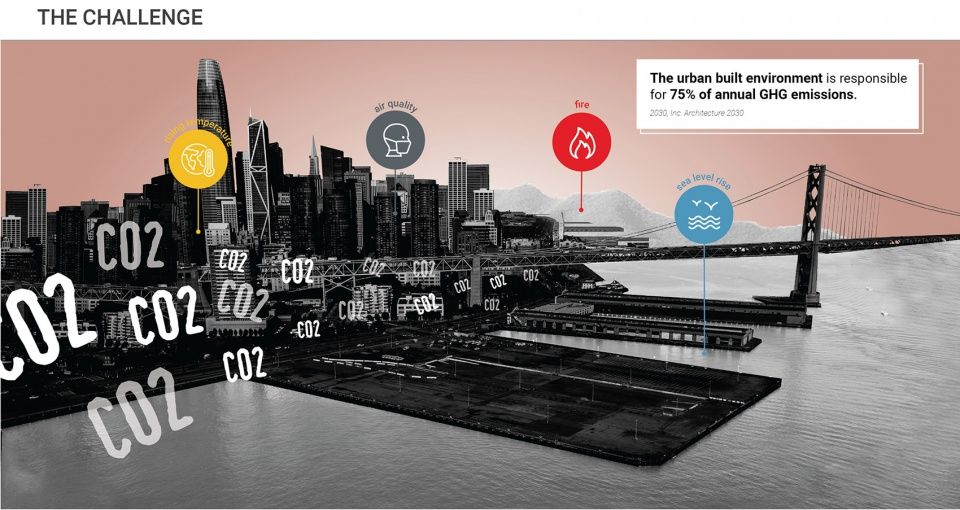
▲挑战:政府间气候变化专门委员会报告显示,我们还有十年的时间来防止气候导致的灾难性时间。建筑2030组织报告称,城市建筑环境每年排放的温室气体占据全球总量的75%。The Challenge: The Intergovernmental Panel on Climate Change reports we have ten years to prevent catastrophic climate related events from happening. Significantly contributing, Architecture 2030 states the urban built environment is responsible for 75% of the world’s annual greenhouse gas emissions.
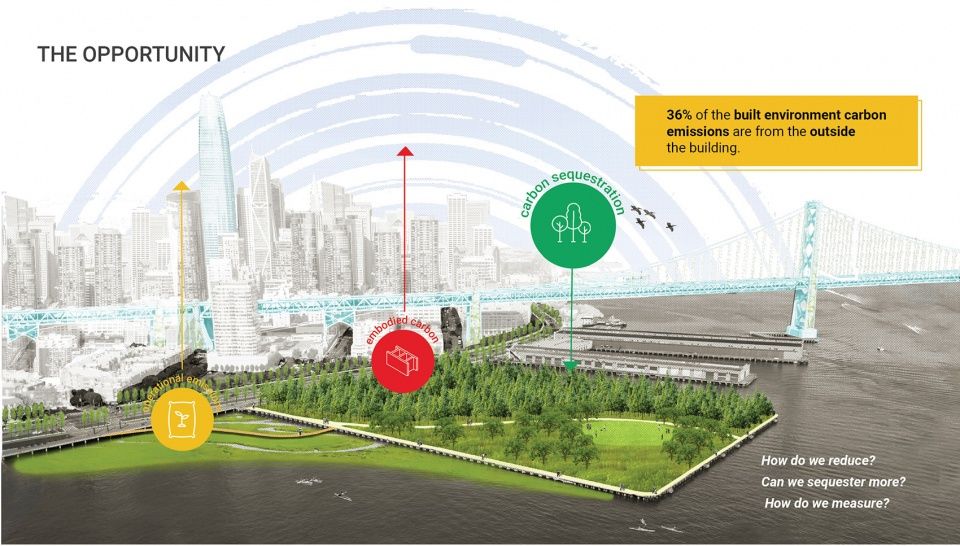
▲机会:在建筑环境产生的碳排放中,有36%来自于建筑物外部。然而,如何通过景观设计来减少碳排放、增加碳固存以及量化这些影响,却一直未能得出清晰的结论。The Opportunity: Out of the emissions generated from the built environment, 36% comes from outside buildings. However, it has been unclear how the landscape architecture profession can contribute to reducing emissions, increasing carbon sequestration, or even measuring those impacts.
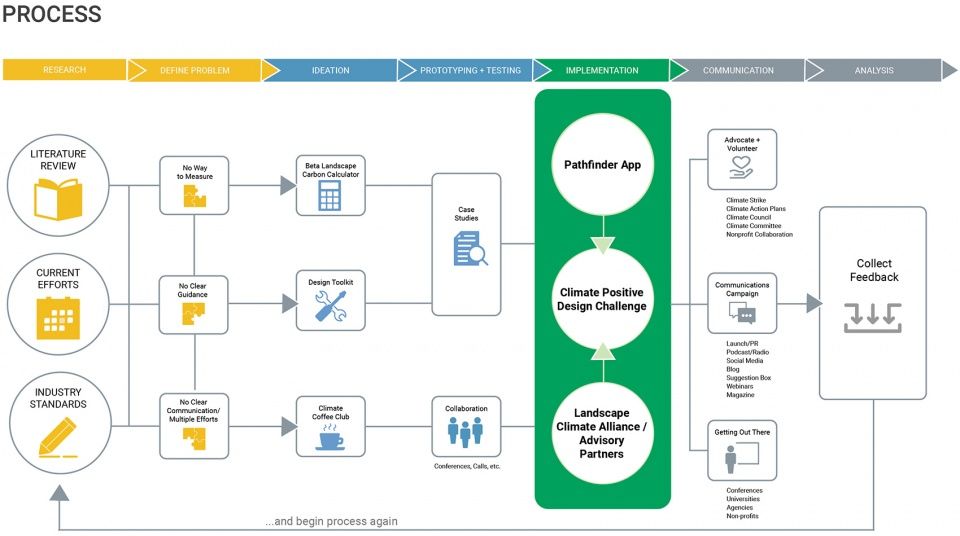
▲步骤:深入的文献回顾为问题的陈述提供了资料,指出了改善景观项目碳影响的工具、指南以及资源的缺乏。在这之后,名为“探路者”的景观碳排放计算器以及“气候积极设计挑战”被开发出来。Process: An in-depth literature review informed the problem statement defining a lack of tools, guidance and resources to improve the carbon impact of landscape projects. Development of the landscape carbon calculator Pathfinder app and Climate Positive Design Challenge manifested thereafter.

▲集体行动:该倡议是40多位有志于改变气候危机的个人共同努力的结果。专注于研究、设计、技术、传播或指导的多学科小组代表了来自5个国家的超过23个不同的国际组织。Collective Action: The initiative is a collective effort of over 40 individuals passionate about making a difference in the climate crisis. Multi-disciplinary sub-groups focus on research and design, technology, communications or guidance and represent five different countries and 23 various international organizations.

▲线上资源:“积极气候设计”网站是对景观设计师、规划师、开发商以及普通园艺师开放的资源,它为如何在建筑环境中减少碳排放和增加碳固存提供了工具、指南与资源。Online Resources: The Climate Positive Design website is a resource for landscape architects, designers, planners, developers, and even the everyday backyard gardener. It houses the tools, guidance and resources to reduce carbon footprints and increase carbon sequestration in the built environment.

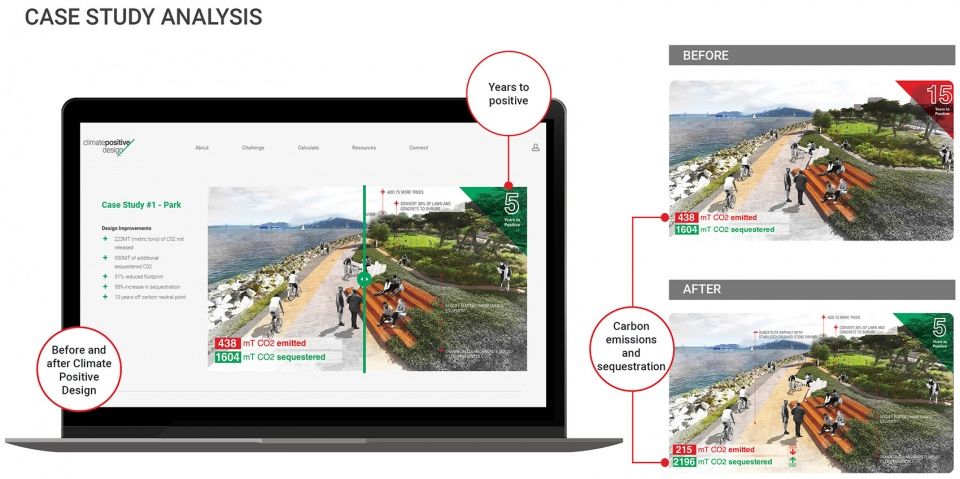
▲对于场地设计项目介入之前和之后的分析,说明了细微变化可能带来的巨大影响。交互式的滑块能够展示如何通过改善措施来缩短实现“碳积极”的年限。Case Study Analysis: Case study analysis of several site design projects “before” and “after” stats illustrate how minimal changes can have a big impact. The slider is interactive revealing how the offset time or “years to positive” is improved.
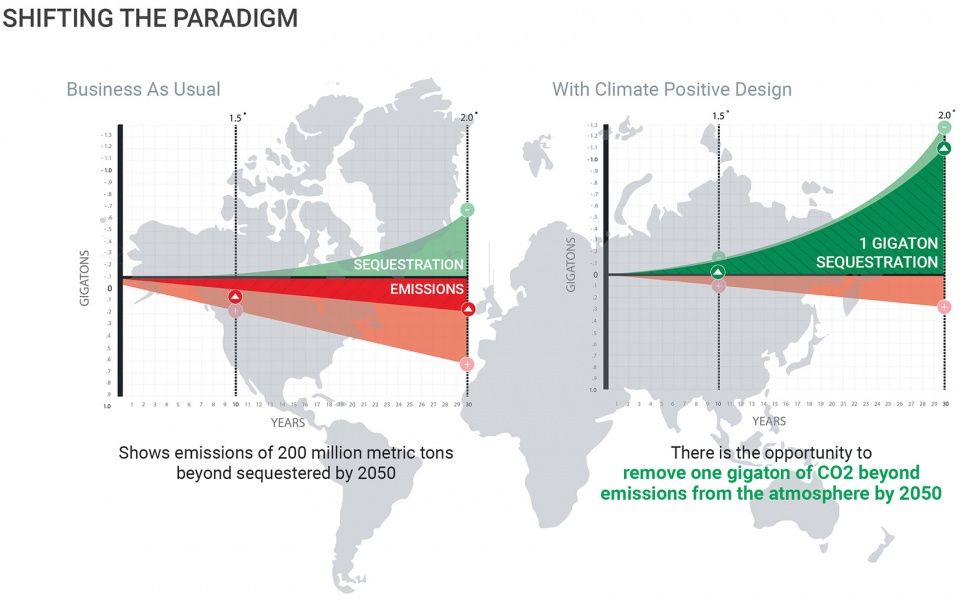
▲转变模式:按照现状不发生任何改变的情况推算,项目的碳排放量将超过碳固存量。而通过案例研究中的简单转变,项目在未来30年的碳固存量将远远大于碳排放量。Shifting The Paradigm: Estimating the current “business as usual” practices of landscape architecture shows emissions exceeding carbon sequestered. However, by making simple changes illustrated in the case studies, the amount sequestered could exceed the amount emitted greatly over the next 30 years.
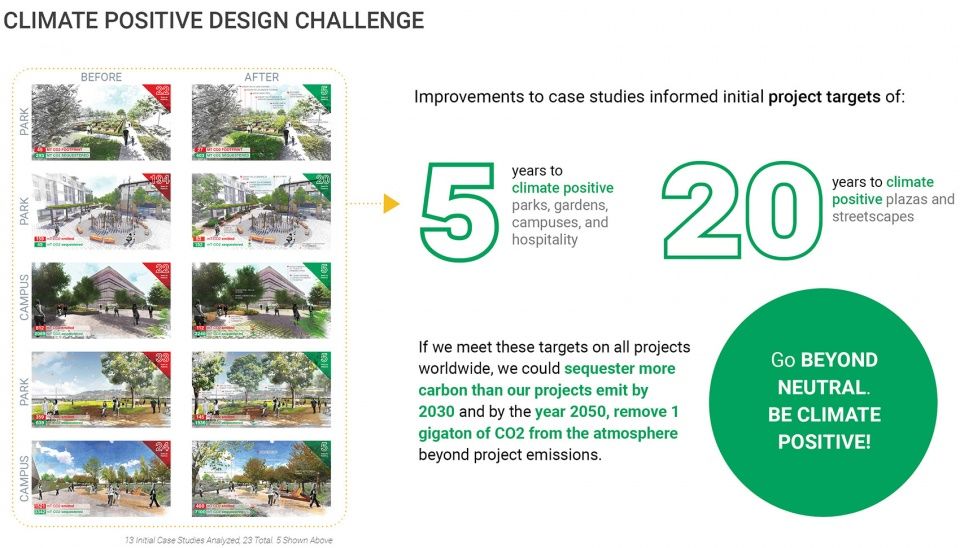
▲气候积极设计挑战:对超过20个建筑项目的详细分析表明了如何在不显著改变设计或降低质量的条件下,如何轻松地实现微小的转变。案例研究分析的结果为制定“气候积极设计挑战”的目标提供了参考。Climate Positive Design Challenge: Detailed analysis of over twenty built projects show how minor changes could have been easily made without significantly impacting the design or reducing quality. The case study analysis findings inform the targets for the Climate Positive Design Challenge.

▲使用“探路者”应用程序:为了实现“气候积极设计挑战”提出的目标,用户可以免费使用名为“探路者”的在线碳排放计算器。教学性的指导流程能够让用户对如何提高项目的固碳量和减少碳排放形成更深一步的了解。Using The Pathfinder App: To meet the goals of the Climate Positive Design Challenge, users access the free web-based carbon calculator called the Pathfinder. Educational onboarding provides a high-level understanding of how projects can sequester more carbon than they emit – becoming Climate Positive.
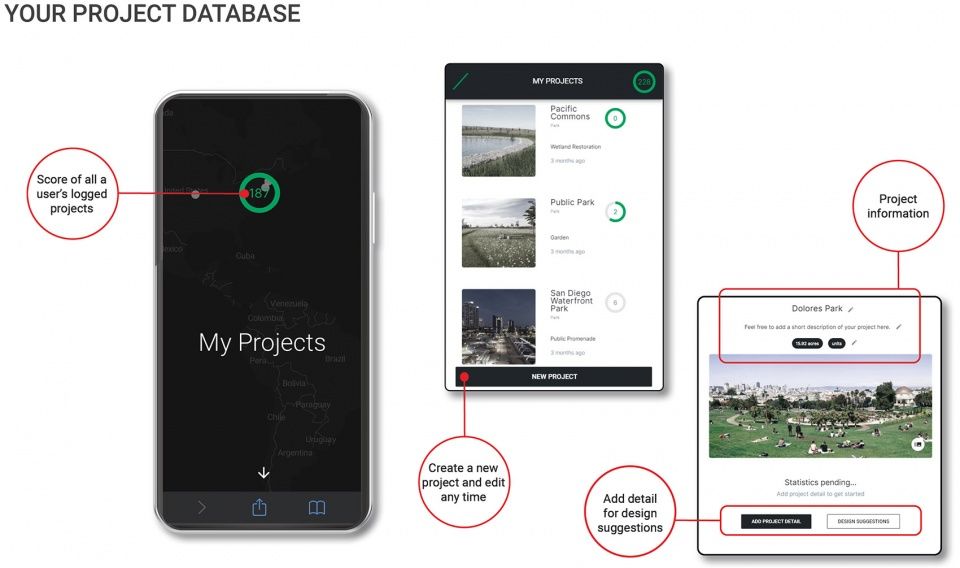
▲你的项目数据库:每位用户或团体都拥有一个可以存储所有项目的专属主页,并且可以随时查看和编辑这些项目——电脑端和移动端均可。Your Project Database: Each user or group has a personal account with all of their projects stored on a homepage, of which they can access or edit any time – from desktop to mobile device.
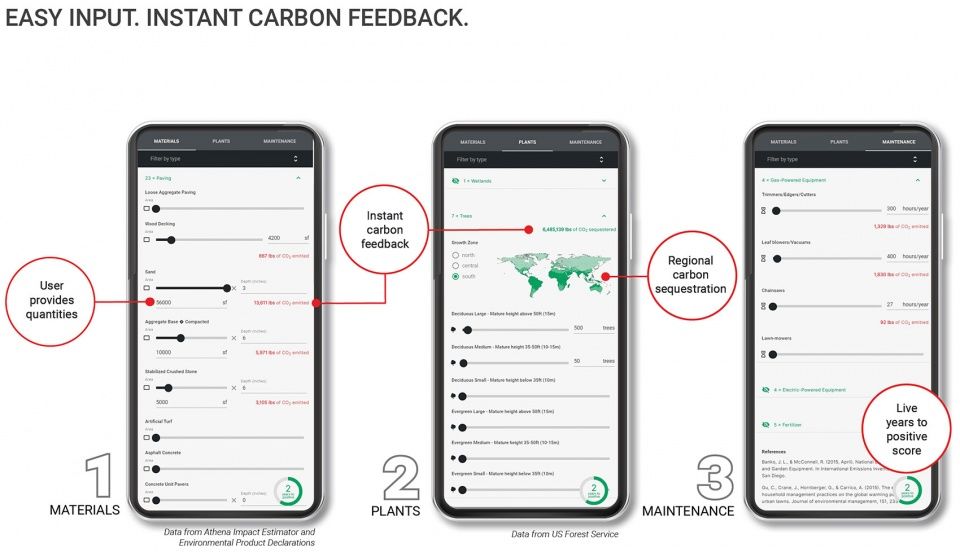
▲轻松输入,即时反馈:用户在将数量输入应用程序之后,将获取到关于材料的碳排放量、植物的固碳量或维护产生的碳排放的即时反馈。用户的“积极年限”得分也将根据每次输入而更新。Easy Input. Instant Carbon Feedback: The user enters quantities into the app to receive instant feedback on embodied carbon emissions from materials, carbon stored (sequestered) by plants and soil, or operational emissions from maintenance. The user’s “Years to Positive” score updates with each input.
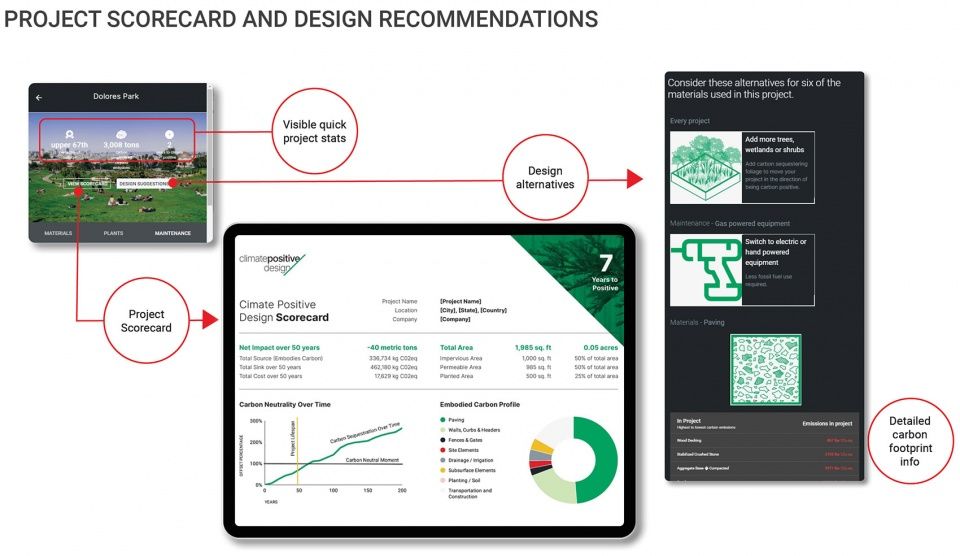
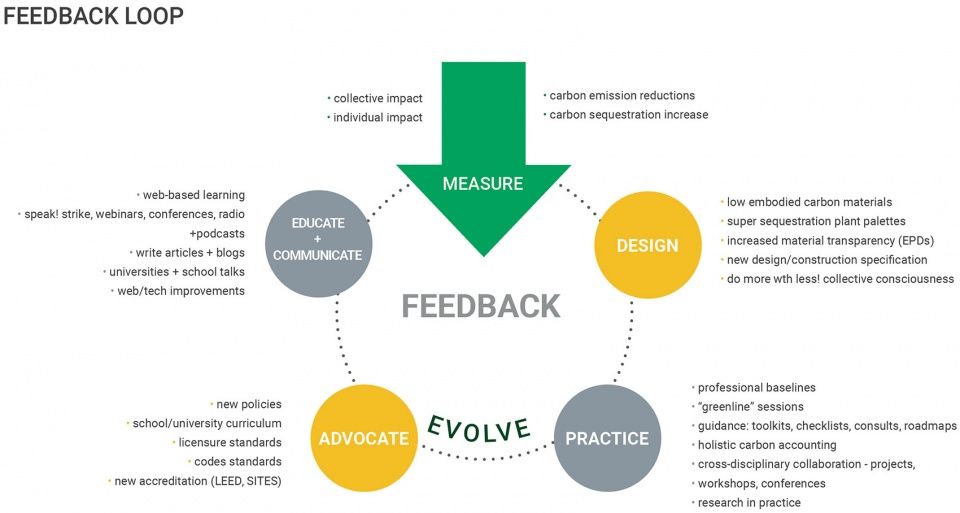
▲反馈环路:通过衡量建筑环境产生的碳排放,一个“反馈环路”得以建立。它能够为我们的设计和实践提供信息和资源。收集到的信息也将为新政策、标准、专业教学内容以及沟通和传达方法提供参考。Feedback Loop: Measuring the carbon generated from the built environment creates a feedback loop that informs how we design, and the resources needed to evolve our practices. Information collected holistically informs setting new policies, how we teach, and communicate.

▲发布后45天数据:在网站发布后的45天内,已有至少80个国家和数千位用户参与进来。虽然这项研究计划依然处于初期阶段,但它在实现气候积极方面的潜在影响力依然十分可观。First 45 Day Statistics: Within the first forty-five days of the launch, awareness of the cause reached at least eighty countries and thousands of people. Although the research initiative is in early stages, the potential impact appears promising in having a Climate Positive impact.
PROJECT NARRATIVE
TIME IS OF THE ESSENCE
In 2019, the Intergovernmental Panel on Climate Change (IPCC) warned that 10-years remains for aggressive reductions in greenhouse gas (GHG) concentrations necessary to prevent a 1.5-degree Celsius temperature increase that will cause irreversible damage to our planet and society if left unchecked.
Architecture 2030 reports that the urban built environment is responsible for 75% of annual GHG emissions. Of those impacts, 36% come from outside buildings. While landscape architecture projects contribute emissions, they also contain trees and plants that take carbon dioxide – the primary GHG – out of the atmosphere.
Landscape carbon systems are complex – they include embodied carbon emissions from material manufacturing and transportation and operational carbon emitted over time through maintenance and fertilizers, but they also sequester CO2 from the atmosphere and store it in trees, plants and soil. Methods to calculate architectural carbon have been developed over the last decade such as Athena, Tally, or One-Click LCA, but due to the organic complexity of site design, the landscape architecture profession has not been able to actively measure, track, or improve the carbon impacts of its collective work.
Can landscape architecture projects sequester more carbon than they emit and contribute to climate positive action?
METHODS
Landscape architects led the research component of this initiative and collaborated with an environmental consultant to advise on industry standards. The primary research methods are as follows:
1. Literature Review: Analysis of seminal publications on climate science, carbon sequestration and storage, embodied carbon of materials and operational emissions.
2. Market and Industry Standard Research: Identifying current climate action efforts of related disciplines, guidance, challenges, standards, rating systems and practices.
3. Case Studies: Testing strategies to reduce emissions and increase carbon sequestration on built projects to better understand which strategies provide the greatest impact.
RESULTS
DATA REPORT: METHODOLOGY, DATA SOURCES AND METRICS
A comprehensive literature review provided a foundational understanding of climate science and its relationship to the built environment. As the IPCC 1.5-Degree Report and “Drawdown” by Paul Hawken were authored during this time, both provided clarity into the urgency of the situation and insight into developing metrics for possible solutions.
The Athena Impact Estimator is the most comprehensive open source of embodied carbon for materials related to the landscape field. The Global Warming Potential (GWP) CO2e value is the main data point, which can also be extrapolated from international Environmental Product Declarations (EPDs).
The US Forest Service sequestration data provided in iTree was used to determine sequestration rates for a range of species varying in size, location and foliage type. The sequestration data is based on planted trees in urban/sub-urban areas rather than that of rates from natural areas. Regional rates vary significantly due to number of growth days per year and set the priority over species type due to a higher variability.
The team performed in-depth case study analysis on over 20 built projects. This included the evaluation of embodied carbon, operational carbon, carbon sequestration, along with the years required to offset project emissions (i.e. years to positive). Through this analysis, project adjustments were made without significantly changing the design while improving carbon impacts. These observations and calculations are recorded in the Data Report.
TOOLS, GUIDANCE AND RESOURCES
The research showed that there is no landscape “magic bullet” for climate change but clearly indicated the need for a carbon calculator specific to landscape architecture.
After evaluating the climate action progress of other disciplines and organizations, understanding performance metrics strategies and engaging the profession at large, Climate Positive Design was created. The website houses a range of tools, guidance and resources, including a Design Toolkit that outlines over 80 different strategies for improving carbon impacts of landscape projects.
Climate Positive Design Challenge
The case studies illuminated that aggregated small changes add up to significant carbon footprint improvement without significantly changing project design or quality. It became clear that urban projects, such as plazas and streetscapes, have a higher carbon footprint per square foot than that of “greener” projects such as parks or campuses that have less program and inherently more planting. Accordingly, the years to offset or “years to positive” was higher for the more urban projects.
Several Design Challenge options were reviewed by Advisory Partner organizations and the agreed upon methodology was to focus on “years to positive” (YTP) as this metric requires both reducing emissions and increasing sequestration. To determine targets for the Climate Positive Design Challenge, an average of the case study projects YTP was selected. For parks, gardens, campuses the YTP target is five years and for streets and plazas the target is set at 20 years.
Using unchanged case study project data, or “business as usual”, and extrapolating that to the global community of approximately 75,000 landscape architects, projections show that projects collectively emit more carbon than they sequester. However, by meeting the goals of the Challenge, the results would instead show projects sequestering more carbon than emitted by 2030 and extracting roughly one gigaton of CO2 out of the atmosphere by 2050 beyond emissions. This impact would fall within the top 80 solutions listed in “Drawdown” by Paul Hawken, that when implemented collectively over the next 30 years will reduce GHG emissions on an annual basis and reverse global warming.
The Pathfinder
To ensure the greatest possible success in the development of a landscape carbon calculator, a survey that was conducted of over fifty landscape architects reported that for them to incorporate carbon analysis into their work, it would: 1) Need to be easy; 2) Integrate with their project work-flow/process, and 3) Show feedback that it would make a difference.
To meet user expectations while maintaining flexibility to evolve over time and to have a global reach, the beta version of the carbon calculator transformed into a web-based application called the Pathfinder.
The app features educational onboarding and a homepage for each user, or company, where projects can be created or edited at any point in time. Users enter quantities for materials, plants, or maintenance plans and receive instant feedback on carbon emissions, sequestration, and their YTP or Climate Positive Score. A scorecard provides detailed stats that can be plugged directly into Life Cycle Assessments (LCAs) and project specific design suggestions help guide users toward improving their project’s impact.
Through the use of the Pathfinder, designers can meet the goals of the Climate Positive Design Challenge by reducing carbon emissions and increasing sequestration.
SIGNIFICANCE
By measuring carbon impacts collectively for the first time as a profession, landscape architects can initiate a feedback loop that informs design and the resources needed to evolve our practices. By requesting EPDs on products and materials, we will collectively signal the importance of carbon footprints to our suppliers. Information collected will inform new policies, standards, what we teach, and how we communicate.
Within the first forty-five days of the launch, initiative awareness reached at least 80 countries and thousands of people. Over 330 projects were logged by 313 contributors – reduction impacts equivalent of taking over 500,000 cars off the road in 30 years by planting close to 130,000 trees. Although initial participation shows a clear increase in awareness, research must be advanced to continue to improve the efficacy of these results – specifically advancements to better understand soil disturbance and more detailed sequestration rates for plant communities beyond tree species.
Additional enhancements to the application database are needed to ensure accuracy of the information collected in relation to meeting the Challenge targets that will be re-evaluated over time. Although the research initiative is still in its early stages, the potential impact appears promising that we can indeed have a Climate Positive impact, but this will only improve through the collective commitment from the profession.
The choice is ours to rise to the challenge – we’re all in this together.




